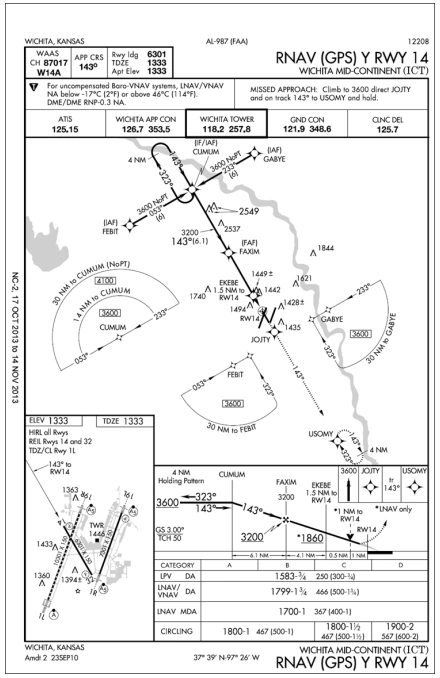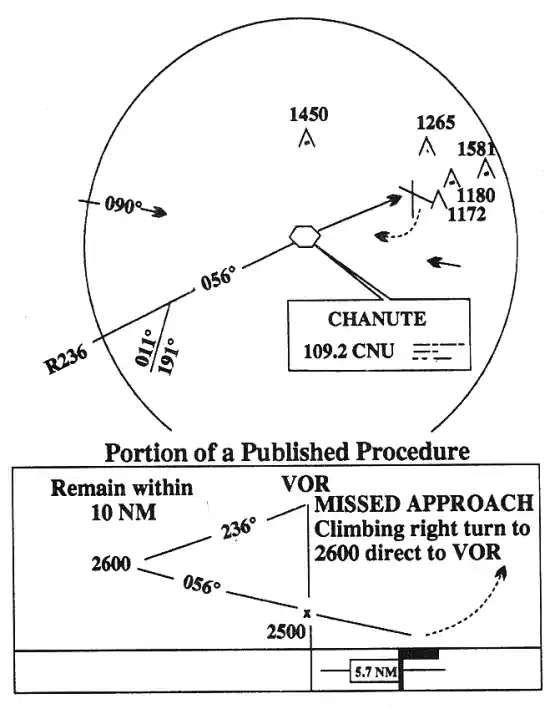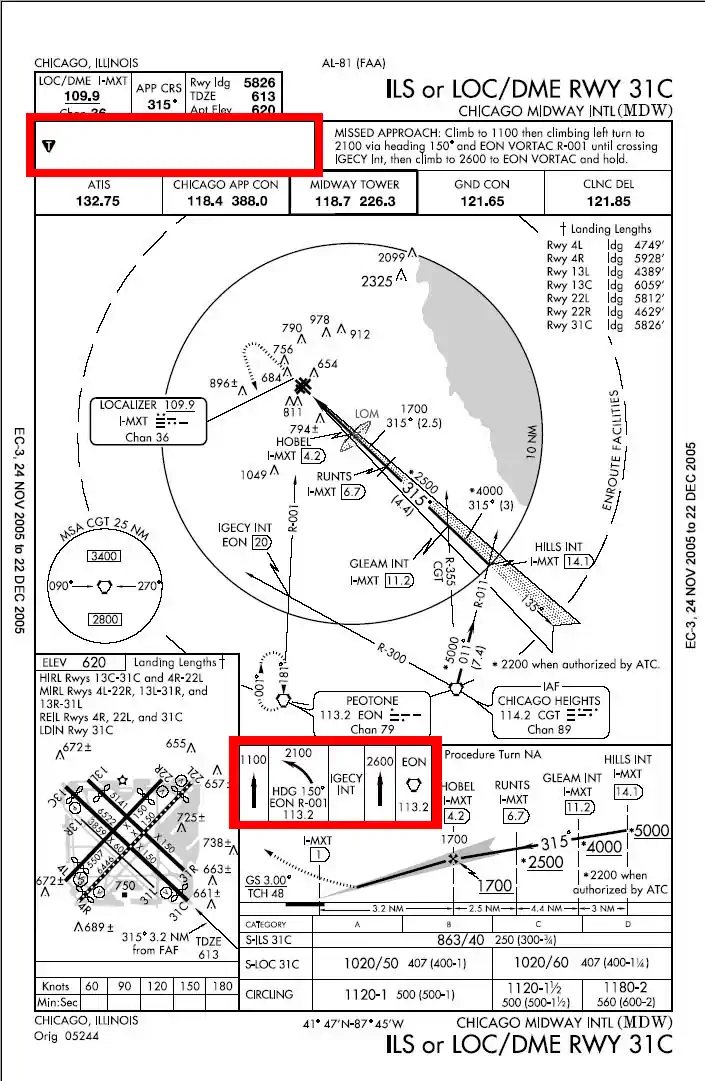
Missed Approach procedure Depiction:
- Missed approaches are depicted on instrument approach charts in textual and graphical formats
-
Profile View Missed Approach Symbology:
- To make missed approach guidance more readily understood, a method has been developed to display missed approach guidance in the profile view through the use of quick reference icons
- Due to limited space in the profile area, only four or fewer icons can be shown
- However, the icons may not provide representation of the entire missed approach procedure
- The entire set of textual missed approach instructions are provided at the top of the approach chart in the pilot briefing [Figure 14]
Missed Approach Conditions:
- Pilots shall go missed if any of the following criteria are met:
- Upon arrival at the Missed Approach Point (MAP) or Decision Height (DH), visual reference to the runway environment is insufficient to complete the landing
- Runway environment, is defined in FAR 91.175
- A safe approach or landing is not possible
- ATC instructs you to
- When the aircraft is being operated below MDA
- Upon arrival at the Missed Approach Point (MAP) or Decision Height (DH), visual reference to the runway environment is insufficient to complete the landing
- Additionally, missed approach procedures may be executed for:
- Training
- Instrument failure
- Other emergency
Missed Approach Clearance:
- Missed approach instructions can comes from two sources:
- Formal, as published on the instrument approach chart
- Verbally, given from ATC
Published Missed Approaches:
- A clearance for an instrument approach procedure implicitly includes a clearance to fly the published missed approach procedure, unless otherwise instructed by ATC
- Instructions are visually depicted on the profile view section of the approach plate while amplifying instructions will appear in the Pilot Briefing and Procedure Notes section [Figure 1]
- A dashed line on the plan view further helps the pilot visualize where they are going and where they are to hold
- In the event a balked (rejected) landing occurs at a position other than the published missed approach point, the pilot should contact ATC as soon as possible to obtain an amended clearance
- If unable to contact ATC for any reason, the pilot should attempt to re-intercept a published segment of the missed approach and comply with route and altitude instructions
- If unable to contact ATC, and in the pilot's judgment it is no longer appropriate to fly the published missed approach procedure, then consider either maintaining visual conditions if practicable and reattempt a landing, or a circle-climb over the airport
- Should a missed approach become necessary when operating to an airport that is not served by an operating control tower, continuous contact with an air traffic facility may not be possible
- In this case, the pilot should execute the appropriate go-around/missed approach procedure without delay and contact ATC when able to do so
- Prior to initiating an instrument approach procedure, the pilot should assess the actions to be taken in the event of a balked (rejected) landing beyond the missed approach point or below the MDA or DA (H) considering the anticipated weather conditions and available aircraft performance
- 14 CFR 91.175(e) authorizes the pilot to fly an appropriate missed approach procedure that ensures obstruction clearance, but it does not necessarily consider separation from other air traffic
- The pilot must consider other factors such as the aircraft's geographical location with respect to the prescribed missed approach point, direction of flight, and/or minimum turning altitudes in the prescribed missed approach procedure
- The pilot must also consider aircraft performance, visual climb restrictions, charted obstacles, published obstacle departure procedure, takeoff visual climb requirements as expressed by nonstandard takeoff minima, other traffic expected to be in the vicinity, or other factors not specifically expressed by the approach procedures
Air Traffic Control:
- ATC will issue their own instructions if it better service their purpose, or yours
- ATC: "[Callsign], upon reaching [Location], [Instructions]"
- Example: "One Seven Two Seven Victor, upon reaching 5 DME, turn left heading 010 and climb to 5,500', vectors ILS 17"
- When approach has been missed, request clearance for specific action; i.e., to alternative airport, another approach, etc.
- In the absence of missed approach instructions, it is implied that you will fly the published missed approach instructions
- This will often be the case when flying a real approach, when training, ATC will likely give you different instructions to set you up for your next approach
- ATC will give you altitude, heading, frequency, and supplementary information as required
- ATC: "Missed approach instructions, climb [Altitude], turn left [Heading] and contact departure [Frequency]. Be advised [Traffic...]"
- At locations where ATC radar service is provided, the pilot should conform to radar vectors when provided by ATC in lieu of the published missed approach procedure
- Pilots must ensure that they have climbed to a safe altitude prior to proceeding off the published missed approach, especially in nonradar environments. Abandoning the missed approach prior to reaching the published altitude may not provide adequate terrain clearance. Additional climb may be required after reaching the holding pattern before proceeding back to the IAF or to an alternate
- If you are on an IFR flight plan, the approach clearance automatically authorizes you to fly the missed approach
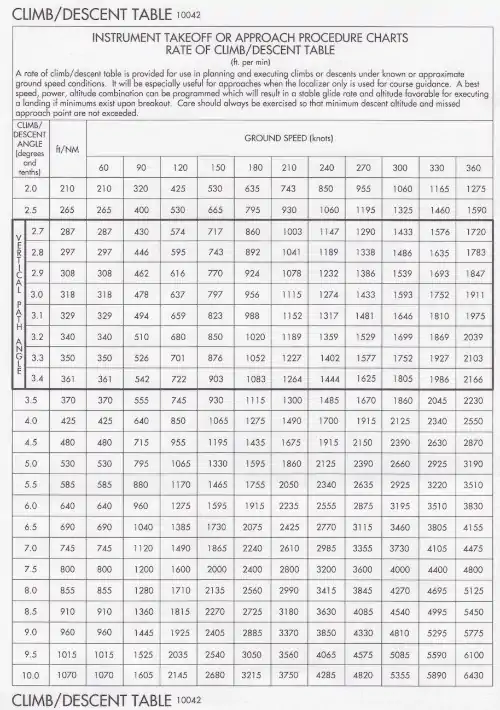
Obstacle Protection:
- Obstacle protection for missed approach is predicated on the missed approach being initiated at the decision altitude/height (DA/DH) or at the missed approach point and not lower than minimum descent altitude (MDA)
- If the aircraft initiates a missed approach at a point other than the missed approach point (see paragraph 5-4-5b), from below MDA or DA (H), or while conducting a circling maneuver, obstacle clearance is not necessarily provided by following the published missed approach procedure, nor is separation assured from other air traffic in the vicinity
- A climb gradient of at least 200'/Nautical Mile (NM) is required, except for Copter approaches, where a climb of at least 400'/NM is required, unless a higher climb gradient is published in the Pilot Briefing and Procedure Notes section of the approach procedure chart
- Pilots must pre-plan to ensure that the aircraft can meet the climb gradient (expressed in feet per nautical mile) required by the procedure in the event of a missed approach, and be aware that flying at a higher than anticipated ground speed increases the climb rate requirement (feet per minute)
- Instructions on calculating the climb rate required (feet per minute) against the climb gradient (feet per nautical mile) can be found on the performance calculations page
- Tables for the conversion of climb gradients (feet per nautical mile) to climb rate (feet per minute), based on ground speed, are included on page D1 of the U.S. Terminal Procedures booklets
- Reasonable buffers against obstacles are provided for normal maneuvers however, no consideration is given to an abnormally early turn
- Therefore, when an early missed approach is executed, pilots should, unless otherwise cleared by ATC, fly the IAP as specified on the approach plate to the missed approach point at or above the MDA or DH before executing a turning maneuver
- When higher than standard climb gradients are specified, the end point of the non-standard climb will be specified at either an altitude or a fix
- A climb gradient of at least 200'/Nautical Mile (NM) is required, except for Copter approaches, where a climb of at least 400'/NM is required, unless a higher climb gradient is published in the Pilot Briefing and Procedure Notes section of the approach procedure chart
- Pilots must ensure that they have climbed to a safe altitude prior to proceeding off the published missed approach, especially in non-radar environments, as abandoning the missed approach prior to reaching the published altitude may not provide adequate terrain clearance
- This may be accomplished by referencing the Minimum Safe Altitude depiction which displays minimum safe altitudes within 25 NM of the point it is referenced off of (usually the local NAVAID) [Figure 3]
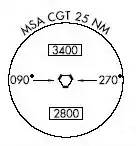
Alternate Procedures
- Some locations may have a pre-planned alternate missed approach procedure for use in the event the primary NAVAID used for the missed approach procedure is unavailable
- To avoid confusion, the alternate missed approach instructions are not published on the chart
- However, the alternate missed approach holding pattern will be depicted on the instrument approach chart for pilot situational awareness and to assist ATC by not having to issue detailed holding instructions
- When the alternate missed approach procedure is implemented by a Notice to Air Missions (NOTAM), it becomes a mandatory part of the procedure
- The NOTAM will specify both the textual instructions and any additional equipment requirements necessary to complete the procedure
- Pilots may reject an ATC clearance for an alternate missed approach that requires equipment not necessary for the published approach procedure when the alternate missed approach is issued after beginning the approach
- However, when the alternate missed approach is issued prior to beginning the approach the pilot must either:
- Accept the entire procedure (including the alternate missed approach);
- Request a different approach procedure, or;
- Coordinate with ATC for alternative action to be taken, i.e., proceed to an alternate airport, etc.
- However, when the alternate missed approach is issued prior to beginning the approach the pilot must either:
- If executing a missed approach prior to reaching the MAP, fly the lateral navigation path of the IAP to the MAP and climb to missed approach altitude, unless the IAP establishes a maximum altitude
- A missed approach assumes you were at the MAP at MDA/DH to guarantee obstacle clearance
- If you have to go missed for any reason not at the missed approach point, then turn toward the missed approach point and execute the missed approach
- You should always be thinking about how to execute the missed approach while circling so it is not a surprise if you enter IMC
- The missed approach is executed for the runway the approach started on, not the runway you were circling to
- The initial turn on a missed approach will always be toward the landing runway until established on a segment of the missed approach
- Always request a follow on action after going missed
- Communicate why you are going missed
- A controller may issue modified instructions, which supersede the published instructions
- Stick to the published approach until ATC tells you otherwise
- If executing instructions different from those on the procedure as dictated by approach, call on the go" or "executing climb out" to reduce confusion
- Remember an MDA is a MINIMUM, you are not allowed to sink below it, period, not even by a foot
- Decision altitude, on the other hand, has a built in buffer to allow for missed at that altitude, to sink down as power is brought in, and climb out begins
- If you think your approach may result in a missed, put a "DRAFT" on request:
- Destination
- Route
- Altitude
- Fuel State
- Time En-route
Communicate:
| If Tower: | "[Place] tower, [Callsign], missed approach [Reason]" |
| If Departure: | "[Place] departure, [Callsign] missed approach off of [Location] climbing through [Altitude] for [Altitude] with request" |
| "DRAFT:" | "[Callsign] would like to put a clearance on request to [Destination] via [Route], [Altitude], fuel [Fuel State in Time], Time [Time En-route]" |
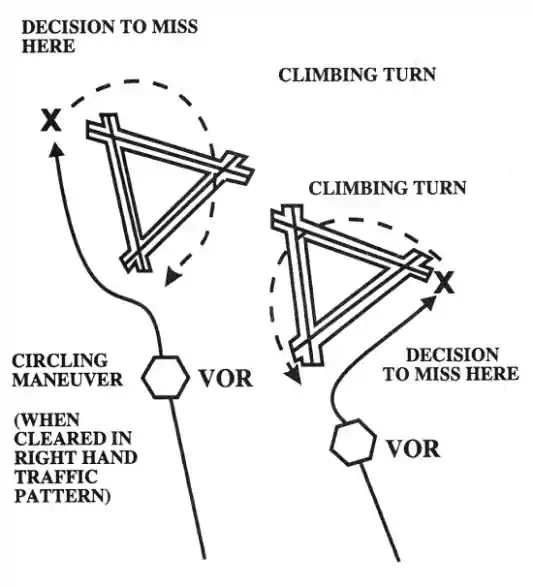
Circle-to-Land (Circling Maneuver):
- A circle-to-land is a maneuver performed at the end of an instrument approach to land on a runway different from the runway which you flew the instrument approach to
- If visual reference is lost while circling-to-land from an instrument approach, the missed approach specified for that particular procedure must be followed (unless an alternate missed approach procedure is specified by ATC)
- To become established on the prescribed missed approach course, the pilot should make an initial climbing turn toward the landing runway and continue the turn until established on the missed approach course
- Inasmuch as the circling maneuver may be accomplished in more than one direction, different patterns will be required to become established on the prescribed missed approach course, depending on the aircraft position at the time visual reference is lost
- Adherence to the procedure will help assure that an aircraft will remain laterally within the circling and missed approach obstruction clearance areas
- Refer to paragraph h concerning vertical obstruction clearance when starting a missed approach at other than the MAP [Figure 1]
Lost Communications Missed Approach:
- If marginal weather conditions exist at destination (and possibly low on fuel after a long flight) file a flight plan or DRAFT with the controller in case of missed approach prior to commencing the approach
- In case of lost communication during the approach and subsequently you take a missed approach due to weather considerations:
- Squawk 7600
- Follow the published missed approach instructions to ensure adequate obstruction clearance
Route:
- Proceed to the alternate IAF as filed and commence an approach
Altitude:
- The EXPECTED altitude, if given one, after filing a DRAFT or;
- Your option of the highest of the two emergency safe altitudes depicted on the destination and alternate approach procedure charts if fields are within 200 NM or each other or
- At flight level 18,000'
- If destination altimeter is 29.92 inches or higher, fly FL180
- If destination altimeter is less than 29.92, fly FL190
Missed Approach Responsibilities:
-
Pilot Responsibilities:
- Executes a missed approach when one of the following conditions exist:
- Arrival at the Missed Approach Point (MAP) or the Decision Height (DH) and visual reference to the runway environment is insufficient to complete the landing
- Determines that a safe approach or landing is not possible (see subparagraph 5-4-21h)
- Instructed to do so by ATC
- Advises ATC that a missed approach will be made. Include the reason for the missed approach unless the missed approach is initiated by ATC
- Complies with the missed approach instructions for the IAP being executed from the MAP, unless other missed approach instructions are specified by ATC
- If executing a missed approach prior to reaching the MAP, fly the lateral navigation path of the instrument procedure to the MAP. Climb to the altitude specified in the missed approach procedure, except when a maximum altitude is specified between the final approach fix (FAF) and the MAP. In that case, comply with the maximum altitude restriction. Note, this may require a continued descent on the final approach
- Cold Temperature Airports (CTA) are designated by a snowflake ICON and temperature in Celsius (C) that are published in the notes box of the middle briefing strip on an instrument approach procedure (IAP). Pilots should apply a cold temperature correction to the missed approach final holding altitude when the reported temperature is at or below the CTA temperature limitation. Pilots must inform ATC of the correction
- AIM, Chapter 7, Section 3, Cold Temperature Barometric Altimeter Errors, Setting Procedures, and Cold Temperature Airports (CTA)
- Following a missed approach, requests clearance for specific action; i.e., another approach, hold for improved conditions, proceed to an alternate airport, etc.
- Executes a missed approach when one of the following conditions exist:
-
Air Traffic Controller Responsibilities:
- Issues an approved alternate missed approach procedure if it is desired that the pilot execute a procedure other than as depicted on the instrument approach chart
- May vector a radar identified aircraft executing a missed approach when operationally advantageous to the pilot or the controller
- In response to the pilot's stated intentions, issues a clearance to an alternate airport, to a holding fix, or for reentry into the approach sequence, as traffic conditions permit
Missed Approach Procedure:
WARNING:
All procedures are GENERALIZED.
Always fly per Pilot Operating Handbook procedures,
observing any relevant Standard Operating Procedures (SOPs)
- At the missed approach point without the approach lights/runway/airport and/or not in a position to make a normal approach and landing, call out, missed approach
- Simultaneously establish an appropriate climb attitude (based on airspeed/pitch attitude at the MAP) and apply full power
- Verify that the mixture control is in the full forward (full rich) position
- Often times the addition of power and subsequent airspeed increase is necessary before pulling the nose up as the aircraft may be on the backside of the power curve and performance therefore slower to respond
- Set the pitch to establish and maintain Vx or Vy, as appropriate
- If applicable, retract the flaps one increment
- With a positive rate of climb established, callout, "Positive Climb"
- As the aircraft accelerates, if applicable, retract the flaps one increment
- As the aircraft accelerates, if applicable, retract the flaps to up
- Report the missed approach to ATC and, if applicable, advise intention
- At 500' AGL, lower the pitch to establish and maintain a cruise climb
- Complete the Climb Flow/Checklist
- Comply with the published missed approach procedure, or as directed
Missed Approach Common Errors:
- Failure to have essential knowledge of the information on the instrument approach chart
- Incorrect communication procedures or noncompliance with ATC clearances or instruction
- Failure to accomplish checklist items
- Faulty basic instrument flying techniques
Missed Approach Best Practices:
- When executing a missed approach, advise ATC and, comply with the missed approach instructions for the procedure being used, or with an alternate missed approach procedure specified by ATC
- When approach has been missed, request clearance for specific action; i.e., to alternative airport, another approach, etc.
- Add power, and rotate gradually, accelerating to climbout speed, and check for two positive rates of climb (Altimeter & VSI)
- Clean up the aircraft as appropriate for aircraft flown (refer to your Pilot Information Manual for appropriate configurations)
- Climb out at appropriate speed
- For MAP procedures that have a speed restriction below 200 KCAS, while turning to the MAP heading to keep a small radius, leave the gear and flaps down and fly on-speed AoA at 5° nose-up until established on the radial, OR fly HALF flaps until on the radial
- If executing the missed due to an inability to break out and land:
- Consider immediately diverting to the planned alternate unless you have reason to believe weather is improving sufficiently to break out
- If the approach was poorly flown, reflying it with emphasize on hitting the numbers
- If there is an emergency, weigh the impacts of flying again, trying another approach with lower minimums, or diverting
Instrument Rating - Missed Approach Lesson Plan:
- To determine the applicant exhibits satisfactory knowledge, risk management, and skills associated with performing a missed approach procedure solely by reference to instruments
- References: 14 CFR parts 61, 91; FAA-H-8083-15; IFP; AIM
Missed Approach Knowledge:
The applicant must demonstrate an understanding of:Missed Approach Risk Management:
The applicant demonstrates the ability to identify, assess, and mitigate risks, encompassing:-
IR.VI.C.R1:
Failure to follow prescribed procedures -
IR.VI.C.R2:
Holding, diverting, or electing to fly the approach again -
IR.VI.C.R3:
Failure to ensure proper airplane configuration during an approach and missed approach -
IR.VI.C.R4:
Factors that might lead to executing a missed approach procedure before the missed
Missed Approach Skills:
The applicant demonstrates the ability to:-
IR.VI.C.S1:
Promptly initiate the missed approach procedure and report it to ATC -
IR.VI.C.S2:
Apply the appropriate power setting for the flight condition and establish a pitch attitude necessary to obtain the desired performance -
IR.VI.C.S3:
Configure the airplane in accordance with airplane manufacturer's instructions, establish a positive rate of climb, and accelerate to the appropriate airspeed, ±10 knots -
IR.VI.C.S4:
Follow the recommended checklist items appropriate to the missed approach/go-around procedure -
IR.VI.C.S5:
Comply with the published or alternate missed approach procedure -
IR.VI.C.S6:
Advise ATC or the evaluator if unable to comply with a clearance, restriction, or climb gradient -
IR.VI.C.S7:
Maintain the heading, course, or bearing ±10°; and altitude(s) ±100 feet during the missed approach procedure -
IR.VI.C.S8:
Use an MFD and other graphical navigation displays, if installed, to monitor position and track to help navigate the missed approach -
IR.VI.C.S9:
Demonstrate SRM or CRM, as appropriate -
IR.VI.C.S10:
Request ATC clearance to attempt another approach, proceed to the alternate airport, holding fix, or other clearance limit, as appropriate, or as directed by the evaluator
Missed Approach Case Studies:
- National Transportation Safety Board (NTSB) Identification: CEN22FA069:
- The NTSB determines the probable cause(s) of this accident to be: The pilot's failure to adhere to the published instrument approach procedure, which resulted in controlled flight into terrain
- National Transportation Safety Board (NTSB) Identification: ERA21LA101:
- The NTSB determines the probable cause(s) of this accident to be: The pilot's in-flight loss of airplane control due to spatial disorientation during a missed approach in instrument meteorological conditions
Conclusion:
- Instrument approaches should be flown with the intention of executing a missed and the possibility of a landing
- If a missed approach is required, advise ATC and include the reason (unless initiated by ATC). Comply with the missed approach instructions for the instrument approach procedure being executed, unless otherwise directed by ATC
- It is legal to request another attempt, but doing so should be based on a reasonable expectation that the result will be different, and not to delay the decision to an alternate
- If compliance with published or alternate missed approach instructions is concerning (for example, it will place you into dangerous weather), then request instructions that mitigate the hazard
- To learn more about instrument procedures, be sure to check out the Instrument Procedures Handbook online or in paperback
- In the case of an ILS where circling is permitted, circling minimums are published, but the missed approach point is at the published missed approach point, not where the glide slipe intercepts the circling minimums
- Note that in the case of an approach continuing visually (breaking out) but a missed is subsequently required, executing the missed approach, even if outside of the protected airspace standards, is all you have
- As part of preflight or approach brief, any published ODPs should be reviewed to get a better idea of hazards on the missed
- Instrument flying is fatiguing meaning a missed approach may be required when most exhausted
- For this reason, don't hesitate to fly to an alternate if required
- Pilots can visit the FAA's Instrument Flight Procedures Information Gateway to review and submit questions related to the how and why certain procedures are as they are
- Still looking for something? Continue searching:
References:
- Federal Aviation Administration - Pilot/Controller Glossary
- Aeronautical Information Manual (5-4-7) Instrument Approach Procedures
- Aeronautical Information Manual (5-4-21) Missed Approach
- Aeronautical Information Manual (5-5-5) Missed Approach
- CFI Notebook.net - Circling Maneuver
- CFI Notebook.net - Notice to Air Missions (NOTAM)
- CFI Notebook.net - Performance Calculations
- CFI Notebook.net - Pilot Information Manual
- Federal Aviation Regulations (91.175) Takeoff and landing under IFR
- OPNAVINST 3710.7U (5.3.5.6) Execution of the Missed Approach
- Aviation Safety Magazine - Flaps or Gear First?
